Invasive Plant Issues: Control of Invasive Chokecherry Trees
Note: The Alaska Division of Agriculture has established a quarantine order to stop the importation, transport and sale of Prunus padus (commonly known as European bird cherry or Mayday tree) and Prunus virginiana (commonly known as the Canada red or chokecherry tree.) In many parts of Alaska, these species displace native trees, shrubs and forbs valuable for wildlife and carry plant diseases harmful to the fruit tree industry.
PMC-00345 View this publication in PDF form to print or download.
Prunus padus and virginiana
by Gino Graziano
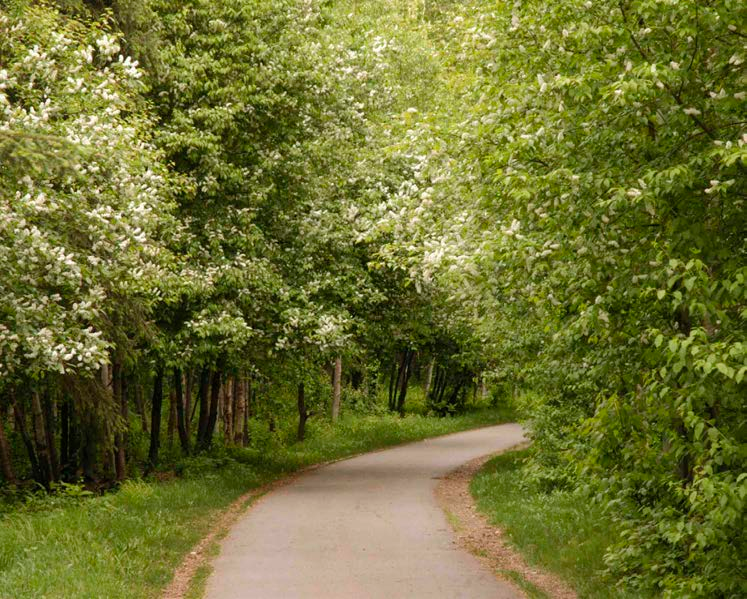
Background: Invasive chokecherry trees in Alaska include European bird cherry (Mayday tree) and Canada red chokecherry, Prunus padus and virginiana, respectively. These tree species were first planted as ornamentals in Alaska during the 1950s. They reproduce by seed and roots, and even sprout new trees from branches still attached to the parent plant. Birds spreading seeds have resulted in infestations across a variety of habitats in Alaska, including river and stream corridors, subalpine areas and black spruce bogs.
Infestations exclude desirable vegetation by forming dense stands. Because it contains cyanide in the branch tips and fruit pits, chokecherry is toxic to moose. These trees, as found in recent studies, also do not support the same quantity or quality of insects that fish rely on. Furthermore, chokecherry resprout after fire, similar to willow and aspen, and without moose as a key control, they may easily become dominant species and have negative long-term consequences in Alaska’s boreal ecosystems.
Impacts of chokecherry:
- Toxic to moose, occasionally causing cyanide poisoning and mortality
- Displaces beneficial plants
- Supports fewer terrestrial insects than native plants, reducing the number that fall into streams, which potentially diminishes the native fish diet
- Creates thick infestations, impeding visibility and access to areas
Identification:
- White flowers form in clusters during late May or early June, lasting about one week.
- Leaves have two small glands at base, unlike any native tree or shrub of Alaska.
- Fruit are green during growth and black when ripe, with woody pits (stones).
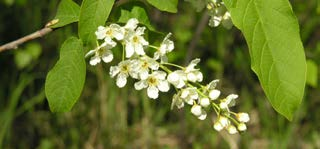
Chokecherry flowers
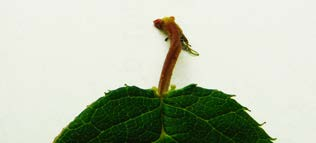
Chokecherry gland
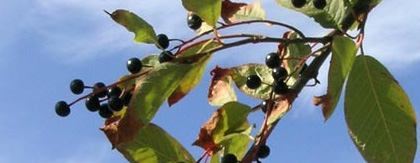
Chokecherry fruit
Control: Chokecherry trees can resprout from roots, trunks and branches left in contact with soil. Thus, eradication requires that both the above- and below-ground plant parts be killed or removed. If complete removal of trees is not possible, herbicides are necessary to kill all reproducible plant parts. Information on herbicides and application methods is included in this publication.
Homeowner: Small trees may be pulled or dug out, but care must be taken to pull any new sprouts that might arise from fragments of remaining roots. Larger trees should have herbicide applied to the tree or trunk to allow roots to be fully killed. After treatment, any remaining above- ground material can be removed as desired. In place of the removed chokecherry, consider planting a desirable noninvasive tree, as trees have many benefits to landscapes, communities and the environment.
Public lands: Permission must be granted before removing any invasive species from property you do not own or manage. Infestations on public lands can be dense and require many techniques for removal. Communities addressing chokecherry infestations usually incorporate community weed pulls and herbicide treatments by licensed professionals. In areas with large infestations, it is paramount to prevent reinvasion and new invasions in surrounding areas. An ideal strategy involves removing large trees, because they produce the most cherries, while addressing other habitat/land management concerns of dense infestations.
Integrated Pest Management (IPM) treatment plan for chokecherry infestations
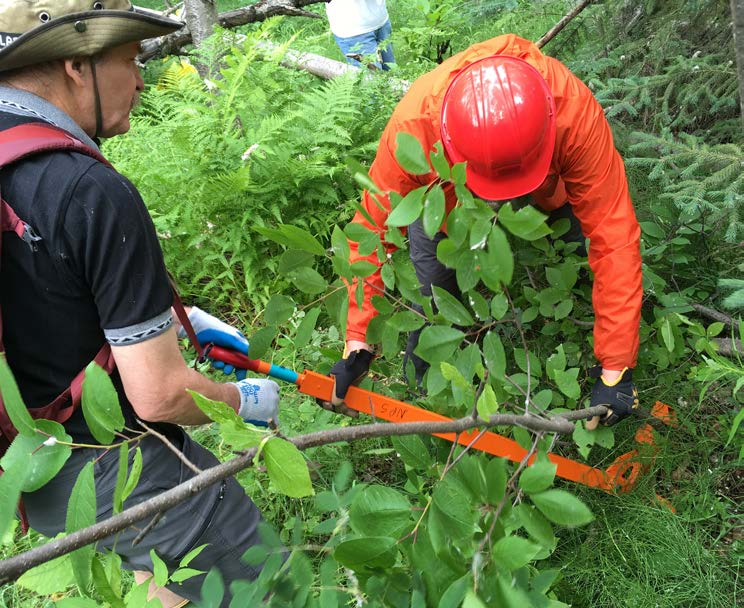
Pulling chokecherry with a weed wrench.
The goal of integrated pest management is to achieve long-term management with minimal impact on human health, the environment and nontarget organisms. Below are some chokecherry control methods.
- Pulling is not recommended unless you are dealing with small trees, less than 3 inches in basal diameter, and a weed wrench is used to pry out roots. Care must be taken to remove root fragments or they will create new sprouts. • Cutting a tree down will not kill the tree because it will regenerate from the remaining trunk, root crown and lateral roots. Applying Epsom salts or other stump-degrading products to the stump after cutting may degrade a small portion of the stump, but will not affect the remaining roots. Application of an herbicide is necessary for trees that cannot be fully removed by pulling or digging.
- Herbicides use in residential sites primarily include products with the active ingredient glyphosate, triclopyr and/or 2,4-D. Forested areas and rights of way may also use products containing imazapyr or aminopyralid. There are many direct treatments for application that can prevent nontarget damage to vegetation around target trees. Restoration of native trees and shrubs may be necessary after removal of dense infestations if native plants are not present to facilitate reseeding. While methods may vary for restoration of native trees and understory vegetation after an infestation is removed, a revegetation plan should be developed to avoid reinfestation of the area with chokecherry or other undesirable vegetation.
Herbicides application options for chokecherry removal
Foliar applications of herbicide involve spraying actively growing leaves. A variety of products can be used for this, and the choice will depend the acceptable level of damage to the surrounding desirable vegetation. Foliar applications are the least direct method of treatment and may have nontarget impacts on surrounding vegetation. This method of treatment should be used on dense infestations that cannot have herbicide efficiently or effectively applied to tree trunks. When dealing with large trees, cutting trees and applying herbicide to regrowth the following season can shorten the trees and ease foliar application.
Cut stump applications involve cutting the tree down and applying a more concentrated herbicide solution directly to the cut surface (follow label instructions). Applications must be made within 30 minutes of cutting because the tree will seal off the wound, preventing uptake of herbicide. Herbicide only needs to be applied to the outer ring just under the bark of the cut stump because this is where the xylem and phloem movement occurs in the physiologically active tissues. Application can be done with a squirt bottle or paint brush. The cut portion of the tree, including branches, should be disposed of to prevent potential resprouting.
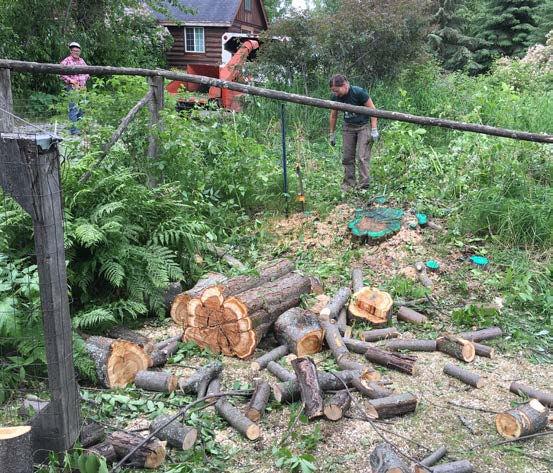
Cut stump application is used with a large chokecherry tree. Herbicide has blue dye added.
Frill treatments involve cutting or chopping through the bark and applying a small amount of a more concentrated herbicide solution with syringe or squirt bottle (follow label instructions). Applications of herbicide should be made immediately after cutting the tree bark. Trees treated this way are left standing to die, and only need to be removed if the dead tree presents a hazard.
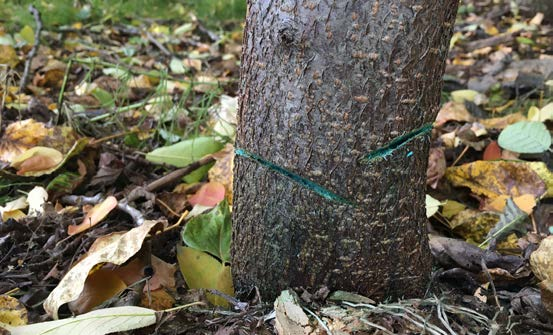
This frill treatment herbicide has blue dye added.
Basal bark treatments are done by application of the herbicide to the lower 12-18 inches of the tree trunk. These applications can be done any time of year when there is not snow on the ground. Trees are left standing to die. This application method may take one to two seasons to kill the entire tree. Basal bark treatments require a mineral oil carrier mixed with specialty herbicides (e.g. ester formulations and aminopyralid), otherwise they are unable to penetrate the bark. Low pressure is used from the application device. These applications are generally most effective on trees less than 6 inches in basal diameter.
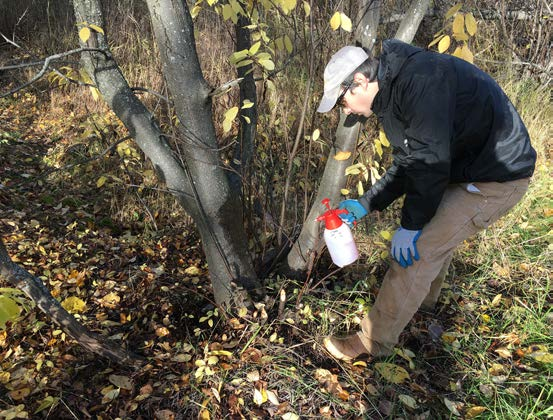
Basal bark treatments.
Injection of herbicides can be made directly to the trunk of the tree using specialized equipment. The equipment propels a capsule containing herbicide into the cambium layer of the tree where it is absorbed. Injections, though expensive, are observed to be highly effective, efficient and selective, only causing damage to the treated trees.
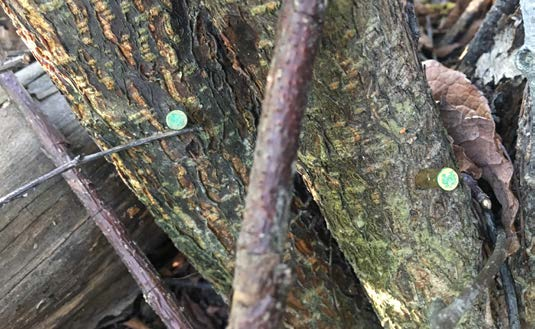
This shows injection treatment; shells containing herbicide are blue.
| Active ingredient | Foliar | Cut stump | Frill | Basal bark | Injection | Sites |
|---|---|---|---|---|---|---|
| Glyphosate | Y | Y | Y | N | Y | Any |
| 2,4-D LV4 | Y | N | Y* | Y* | N | Any |
| Triclopyr | Y** | Y | Y | N | N | Forest/range/non-crop |
| Triclopyr-ester | Y | Y | N | Y | N | Forest/range/non-crop |
| Imazapyr | Y | Y | Y | Y | Y | Forest/range/non-crop |
| Aminopyralid | Y | Y | Y | Y | N | Forest/range/non-crop |
*Can be used for basal bark when in the 2,4-D ester formulation and mixed with the triclopyr ester formulation.
**Some products containing triclopyr can be used on home landscapes for woody vegetation control with foliar applications.
Not sure you know how to apply herbicides safely and correctly? Contact your local Cooperative Extension Service office to learn more (www.uaf.edu/ces).
Always read an herbicide label before applying to ensure it is registered for the site and you use it at the right rate.
Remember the LABEL IS THE LAW!
References
Alaska Exotic Plant Information Clearinghouse. 2005. Invasive Plants of Alaska. Alaska Association of Conservation Districts Publication, Anchorage, Alaska.
Roon, D.A., M.S. Wipfli, T. L. Wurtz and A. L. Blanchard. 2016. “Invasive European bird cherry (Prunus padus) reduces terrestrial prey subsidies to urban Alaskan salmon streams.” Canadian Journal of Fish and Aquatic Science 73:1679-1690.
Woodford, R. and C. Harms. 2011. “Cyanide-poisoned Moose Ornamental Chokecherry tree a Devil in Disguise.” Alaska Fish and Wildlife News, Alaska Department of Fish and Game. Retrieved from www.adfg.alaska.gov/index.cfm?adfg=wildlifenews.view_article&articles_id=501.
Gino Graziano, Extension Invasive Plants Instructor
New November 2020
